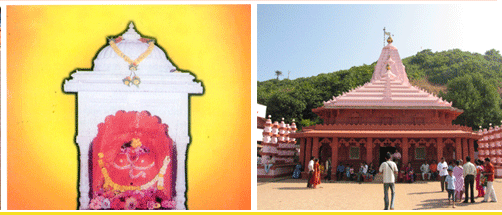



| Hotels In Ganpatipule |
|
Ganpatipule - At Present In 1993 then chief minister of Maharashtra State Shri Sharadrao Pawar visited the temple of Shree Ganesh at Ganpatipule, and inquired about the development plan of the Devasthan. He sanctioned Rs. 25 Lacs donation for this purpose. A committee was formed under the chairman ship of the District collector of Ratnagiri for implementing the development plan under the guidance of this committee, a magnificent temple a large main gate, Pradakshina path, toilets, health centre, office for Devsthan, spacious Sabhamandap for devotees, treasury, a commercial complex, police station, etc, was planned. Construction which is still going on, at an estimated cost of Rs. 10 crores of which Rs. 2.6 crores are required for internal renovation of the temple, which is funded by Devsthan and the cost of development of surrounding area by Maharashtra Government. Administration of Shree Sansthan Ganpatipule In those days the expenses were incurred by the rulers of States Rs. 1173 for the daily playing of drums and Shehanai, Rs. 900 for the payment of salaries of servants, Rs. 960 for festivals. Till the regime of Peshwas the financial provisions were through a clerk looking after Ratnagiri Subha (Division). After the peshwa's regime ended the British rule was established. In 1941, the first Panch committee for Devasthan was formed. Voiceroy Mr. Auckland arranged for the counting and evaluation of treasury and other properties and handed over all these in the custody of this Panch committee. The authority and the rights were now in the hands of this committee for all the functions of Shree Devstahan including appointment of servants. There was no written bye-laws for the administration of the devesthan upto 1912. Latter, on as provided in the bye-laws, residents of Malgund, Nevare, Bhandarpule only could be the members of the Panch Committee. The committee elects the Sarpanch, under whose Leadership the management of Devasthan was looked after. The area of the hill, including the shapeless image of the idol Shree Ganesh, measures 20 acres. This land is owned by Devasthan of Shree Ganesh, along with 7 to 8 pieces of land around. But presently, it is managed by the Pujari Puranik the worshipper. Since last 2 to 3 decades on the day of Sankashta Chaturthi (the fourth day of the astrological month) and when this 4th day falls on Tuesday (The Angarki chaturthi) festivals - Jatra is held on a large scale. Pilgrims in thousands from for away places visit this place, then at times the management becomes difficult. The natures bountiful scenery and greenery, courteous attitude and the hospitality of the residents, Sanctity of the temple, attract people in thousands. They bow their heads at the feet of Shree Ganesh, get blessings and return satisfied with the faith they have. Any one can enter the central place, where the idol is, (Gabhara) to perform puja, provided one has taken a bath and has loin - a particular type of Silk cloth (Sovale). This custom is ob served scrupulously. The central place where the idol is, is slightly two steps lower than Sabhagar level. The floor of the central place is covered by marble tiles and a decorated designed frame for an idol where a Prastrasheela ( a stone slab) measuring 3 ft. by 2 and half ft. covered with a red lead (Shendoor) is visible and that is the Ganesh idol, devoid of any shape with as a trunk and other limbs arranged in the form by flowers. At the front, to the north, magnificent main gate attracts the attention of devotees. Infront of main gate carrier of Shree Ganesh; a large mouse of bronze metal faces the main gate. On both the sides of main gate, two elephants with raised trunks, welcome the devotees visiting Shree Ganesh temple. Inside the main gate to the right is the building named after Sou Ramabai Peshwa, where one can put up for few days at a nominal charges. Income of Devasthan |